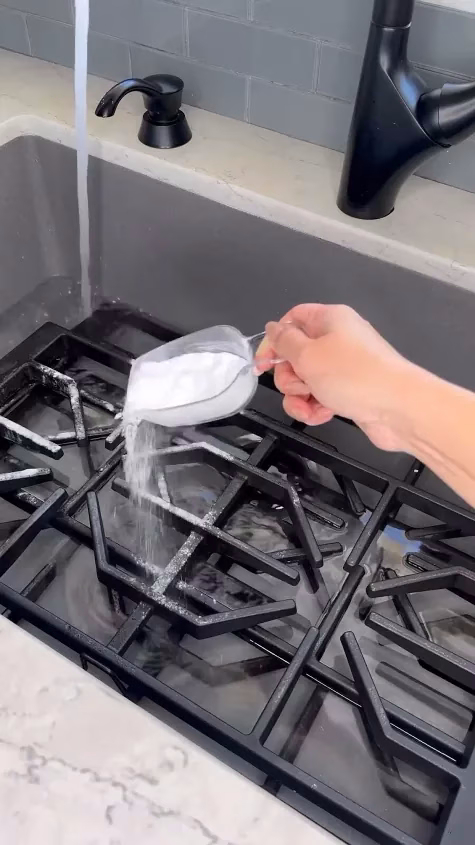ADVERTISEMENT
The Power of Steam: A DIY Steamer for Tough Grime
Steam is a remarkably effective, chemical-free way to loosen and dissolve baked-on grime, especially on surfaces like enamel or stainless steel cooktops where you want to minimize scrubbing.
- The Hot Towel Method: For localized, stubborn spots, dampen a clean dish towel with very hot water (be careful not to burn yourself). Place the hot, wet towel directly over the stubborn stain. Let it sit for 15-30 minutes. The heat and moisture will penetrate and soften the baked-on residue. After the towel has cooled, you’ll find the grime much easier to wipe or gently scrape away.
- DIY Steam Cleaning with a Pot: If you have a pot that fits reasonably well over a particularly large or difficult stain on your cooktop, you can create a makeshift steamer. Put a small amount of water in the pot, place it directly over the stain, and bring the water to a boil. Allow the steam to penetrate the grime for 5-10 minutes (keeping an eye on the water level to prevent it from boiling dry). The steam will lift and soften the gunk, making it easier to wipe away once the surface cools slightly. Use caution when removing the hot pot.
Steam is particularly effective on grease and carbonized food, making the job less labor-intensive and more environmentally friendly. But what about grime that has fused itself to the surface overnight?
Overnight Methods for the Truly Tenacious Grime
Some stains require more than just a few minutes; they need a long, uninterrupted soak to truly break down. This is where overnight methods come in handy:
1. Baking Soda & Dish Soap Overnight Paste:
- For large, heavily soiled areas on the cooktop, create a thick paste of baking soda, a few drops of dish soap, and just enough water. Spread this paste generously over the entire affected area. Cover it with plastic wrap (to keep it moist and allow it to work effectively without drying out) and leave it overnight.
- In the morning, the grime will be significantly softened, allowing you to easily wipe it away with a damp cloth or non-abrasive sponge.
2. Ammonia Tent for Grates (Revisited):
- As mentioned before, for extremely crusted grates or burner caps, the ammonia bag method (placing items in sealed bags with a small amount of ammonia, left outdoors overnight) is unparalleled for breaking down tough, baked-on grease through fumes. Always remember the extreme safety precautions associated with ammonia.
These methods leverage dwell time, allowing the chemicals to work deep into the grime’s structure, making mechanical removal significantly easier. But sometimes, a specific type of stain calls for a unique solution.
The Surprising Role of Lemon Juice and Other Uncommon Remedies
Beyond the common baking soda and vinegar, a few other surprising household items can be incredibly effective:
- Lemon Juice for Hard Water Stains/Light Rust: The citric acid in lemon juice is excellent for dissolving mineral deposits (hard water spots) and even tackling light rust spots on stainless steel or enameled surfaces. Squeeze fresh lemon juice onto the affected area, let it sit for 10-15 minutes, then scrub and rinse. Its natural scent is also a bonus!
- Salt and Dish Soap Scrub: For slightly abrasive but gentle scrubbing, mix a handful of coarse salt (kosher or sea salt) with a good amount of dish soap to create a thick scrub. This can be effective on cast iron grates or very durable enamel surfaces for removing burnt-on bits without harsh chemicals.
- Ice Cubes for Chewing Gum/Waxy Spills: If you ever get chewing gum, wax, or similar sticky substances on your cooktop, don’t scrape it warm. Instead, place an ice cube on it for a few minutes to freeze and harden the substance. Once brittle, it can usually be pried off with a plastic scraper.
These unconventional methods are often the key to overcoming those seemingly impossible cleaning challenges, turning potential frustrations into satisfying “aha moments.” But what about the spills that fuse themselves into a plastic-like residue?
Dealing with Burnt Sugar and Melted Plastic
These two are the bane of any cooktop’s existence, as they melt and bond intensely to the surface. They require specific, careful approaches:
- Burnt Sugar: Act quickly! While the stove is still warm (but not hot enough to burn you), cover the burnt sugar with a damp cloth. The warmth will help to re-liquefy the sugar slightly, and the moisture will begin to dissolve it. Once it’s softened, you can carefully scrape it with a plastic scraper or a razor blade held at a very low angle. For truly baked-on sugar, the hot towel method (from the “Power of Steam” section) is also highly effective.
- Melted Plastic: First, allow the plastic to cool and harden completely. Never try to scrape it off while it’s hot and gooey, as you’ll just spread it and potentially damage the surface. Once cool and hard, try the ice cube trick to make it brittle. Then, very carefully try to pry it off with a plastic scraper or a razor blade (again, at a very low angle). For stubborn remnants, a small amount of nail polish remover (acetone) on a cotton ball can sometimes dissolve small plastic residues, but test in an inconspicuous spot first, as acetone can damage some finishes.
These specific strategies turn potential disasters into manageable clean-ups. But even after all this, sometimes a subtle reminder of past meals lingers in the air. How do you banish those ghost odors?
SEE NEXT PAGE
ADVERTISEMENT
